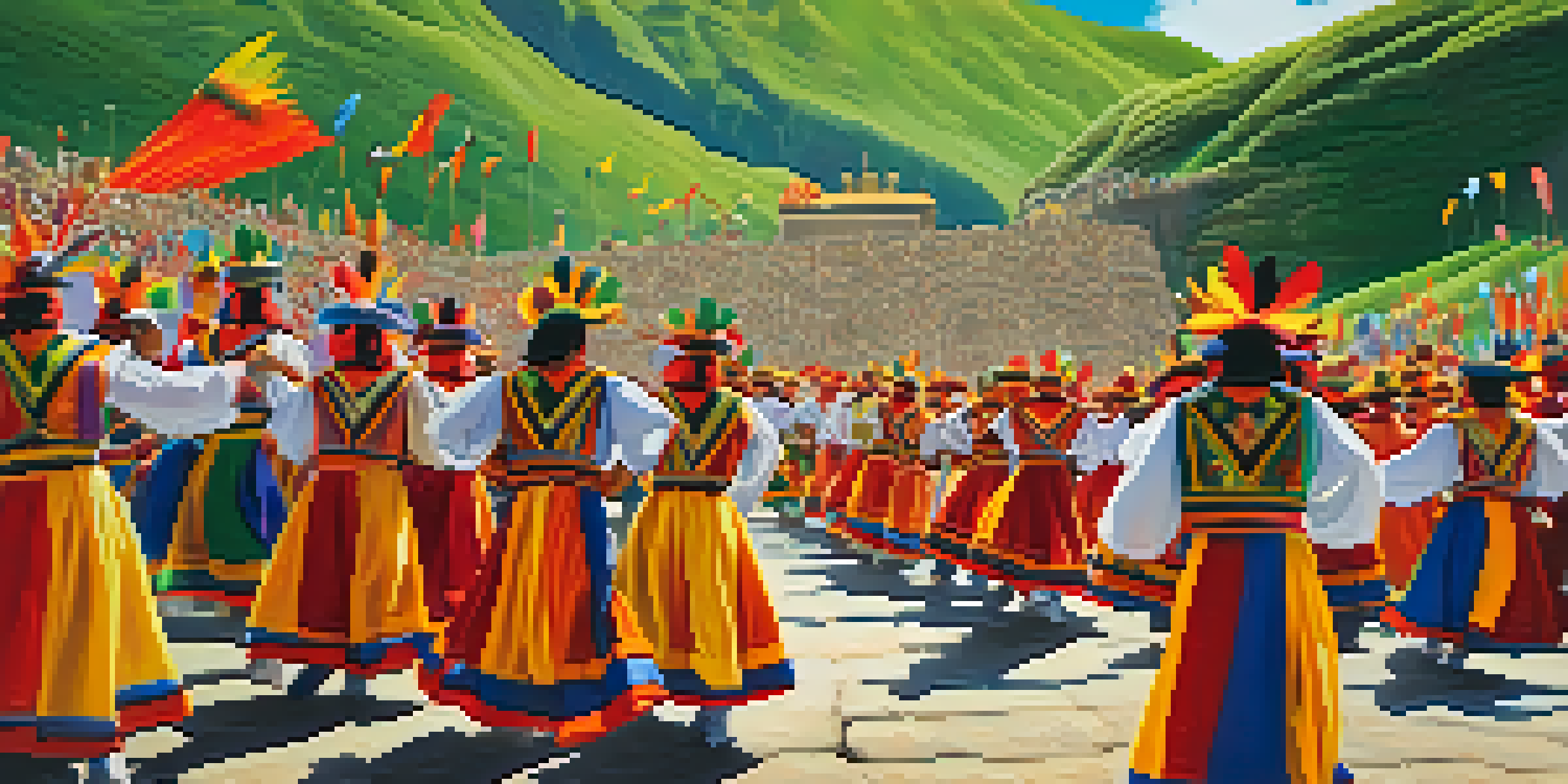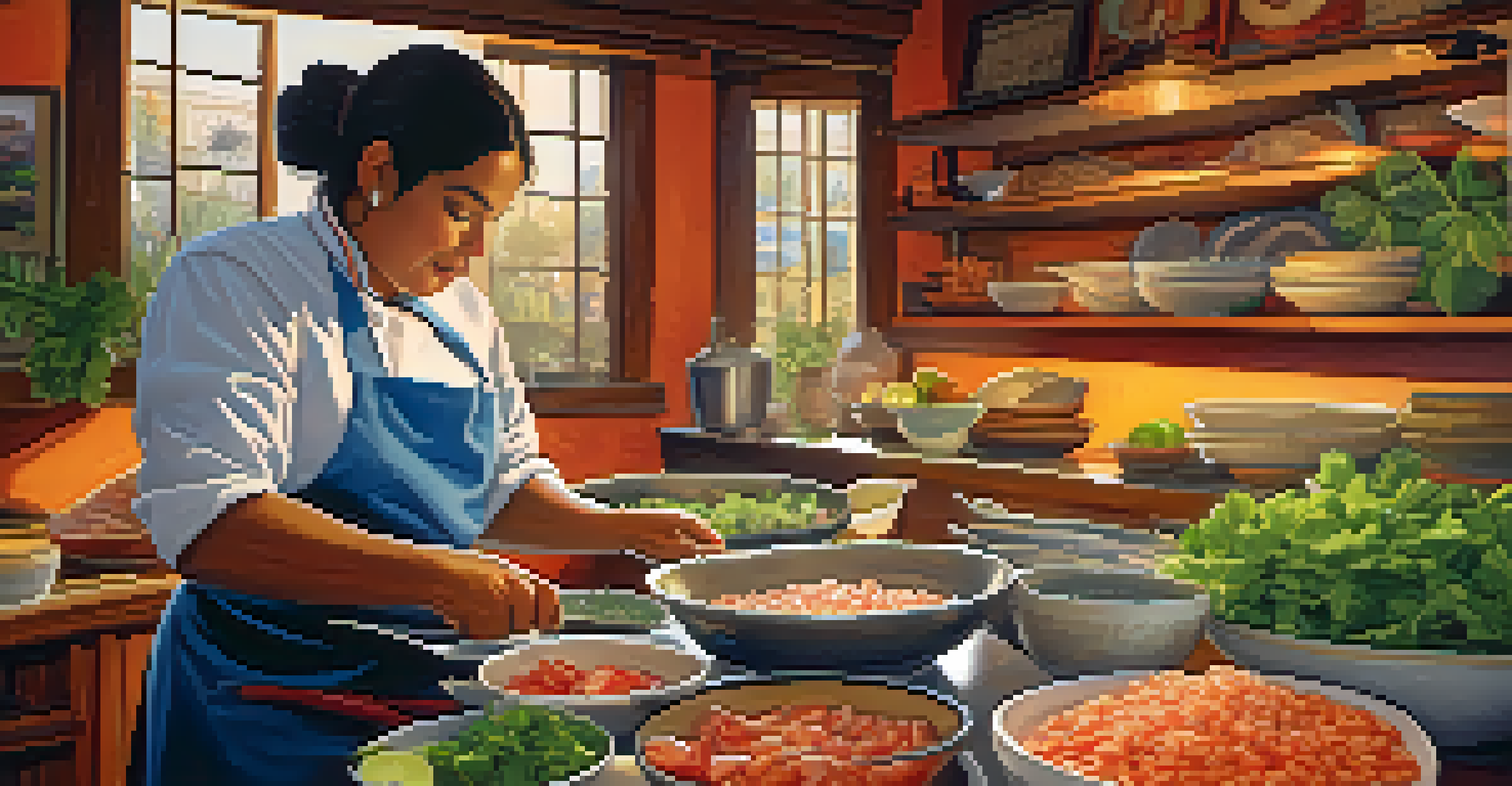Understanding Peru's Cultural Heritage Through Exchange

Peru's Rich Tapestry of Cultural Influences
Peru is a melting pot of cultures, with influences from Indigenous peoples, Spanish colonizers, and immigrant communities. This blend creates a unique cultural tapestry that is evident in everything from language to cuisine. The rich history of Peru is showcased through festivals, music, and art that draw on various traditions and practices.
A culture is as rich as the diversity of its influences.
For instance, the celebration of Inti Raymi, or the Festival of the Sun, highlights the ancient Inca traditions while integrating elements from modern Peruvian society. This festival is a vivid reminder of how past and present coexist in Peru's cultural landscape. People from diverse backgrounds come together to honor their shared heritage, fostering a sense of community.
Cultural exchanges further enrich this tapestry by introducing new ideas and practices. Through these interactions, Peruvians can learn from others while sharing their own traditions, creating a dynamic cultural environment that evolves over time.
The Role of Language in Cultural Exchange
Language is a fundamental aspect of cultural identity and plays a significant role in exchanges. In Peru, Spanish is the dominant language, but numerous Indigenous languages, like Quechua and Aymara, are spoken as well. This linguistic diversity reflects the country’s rich historical background and fosters deeper connections during cultural exchanges.

When individuals engage in language exchange, they not only learn to communicate but also gain insights into the cultural nuances that words carry. For example, certain expressions in Quechua reflect a deep connection to nature, illustrating how the Indigenous worldview influences daily life. Such exchanges can lead to a greater appreciation for different perspectives.
Cultural Diversity Shapes Peru
Peru's rich cultural tapestry is a result of Indigenous, Spanish, and immigrant influences that manifest in language, festivals, and cuisine.
Moreover, language initiatives, such as bilingual education programs, promote inclusivity and understanding. By encouraging the learning of Indigenous languages alongside Spanish, Peru fosters a sense of pride in cultural heritage while strengthening community bonds.
Culinary Exchanges: A Flavorful Journey
Peru’s cuisine is renowned worldwide, and culinary exchanges play a vital role in showcasing its cultural heritage. The fusion of Indigenous ingredients, Spanish techniques, and Asian influences has created a vibrant culinary scene. Dishes like ceviche and lomo saltado are perfect examples of how cultural exchanges can result in delicious innovations.
Food is the ingredient that binds us together.
Food festivals and culinary events are platforms for chefs and home cooks to share their creations and stories. These events often invite international chefs, allowing them to experience and reinterpret traditional Peruvian dishes. This exchange not only highlights Peru's gastronomic diversity but also promotes cultural appreciation through shared meals.
Additionally, cooking classes and workshops encourage locals and tourists to explore Peruvian cuisine hands-on. Participants learn about the history and significance of various ingredients, creating a deeper connection to the culture. Through these culinary exchanges, the flavors of Peru continue to inspire and unite people worldwide.
Art and Craftsmanship: A Shared Legacy
Art and craftsmanship in Peru reflect the country's diverse cultural heritage. Traditional practices, such as weaving and pottery, are often passed down through generations, preserving Indigenous techniques. These artisanal crafts are not only beautiful but also carry stories that connect the makers to their ancestors and communities.
Cultural exchanges enhance the visibility of Peruvian arts on a global scale. International exhibitions and collaborations allow artisans to showcase their work, learn new techniques, and gain inspiration from artists worldwide. This reciprocal exchange enriches their craft, fostering innovation while maintaining traditional roots.
Language Bridges Cultural Gaps
The coexistence of Spanish and Indigenous languages in Peru fosters a deeper understanding and appreciation of diverse cultural perspectives.
Moreover, workshops and artist residencies facilitate direct interactions between local artisans and foreign artists. These experiences create an environment of mutual learning and respect, where ideas flow freely. As a result, Peru's artistic landscape continues to evolve, reflecting both its rich heritage and contemporary influences.
Festivals: Celebrating Diversity and Unity
Festivals in Peru serve as vibrant expressions of cultural heritage and community spirit. Events like the Carnival of Ayacucho and the Feast of the Virgin of Candelaria showcase a blend of Indigenous, African, and Spanish traditions. These celebrations not only honor the past but also invite participation from diverse groups, reinforcing social bonds.
During these festivals, people engage in music, dance, and colorful parades, creating an atmosphere of joy and unity. The cultural exchange that occurs during such events allows participants to share their unique traditions while learning from one another. This interaction fosters a deeper understanding and appreciation of Peru's rich cultural landscape.
Furthermore, festivals often attract tourists, providing an opportunity for cultural tourism. Visitors can immerse themselves in the local customs and traditions, creating memorable experiences that highlight the interconnectedness of global cultures. Through these celebrations, Peru showcases its heritage while embracing the beauty of diversity.
Cultural Preservation in a Globalized World
In an increasingly globalized world, preserving Peru's cultural heritage is essential. While cultural exchanges bring new ideas and practices, they can also pose challenges to traditional customs and languages. Efforts to document and promote these elements are vital for ensuring that they are not lost amidst modernization.
Organizations and communities are working together to safeguard Peru's heritage through various initiatives. For example, cultural preservation projects often focus on revitalizing Indigenous languages and promoting traditional arts. These efforts encourage younger generations to appreciate and participate in their cultural heritage.
Preserving Heritage Amid Globalization
Efforts to document and promote Peru's traditional customs and languages are essential to safeguard its cultural identity in a globalized world.
Moreover, digital platforms have become valuable tools for cultural preservation. Online archives and social media can help share stories, traditions, and art with a global audience. By harnessing technology, Peru can maintain its cultural identity while engaging in meaningful exchanges with the world.
The Future of Cultural Exchange in Peru
The future of cultural exchange in Peru looks promising, as globalization continues to foster connections between diverse cultures. With a growing interest in sustainable tourism, more visitors seek authentic experiences that allow them to engage with local traditions. This trend encourages a healthy exchange of ideas while supporting local communities.
Educational programs focusing on cultural awareness and appreciation are also gaining traction. Schools and universities are increasingly offering courses that highlight Peru's rich heritage, encouraging students to explore and celebrate their cultural identity. This investment in education lays the groundwork for a future generation that values cultural diversity.

As Peru continues to navigate the complexities of cultural exchange, it remains crucial to maintain a balance between embracing new influences and preserving core traditions. By fostering open dialogue and collaboration, Peru can ensure that its vibrant cultural heritage thrives for years to come.